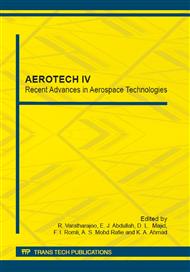[1]
G. Manson, K. Worden, K. Holford, and R. Pullin, Visualisation and dimension reduction of acoustic emission data for damage detection, Journal of Intelligent Material Systems and Structures, 2001, 12(8), pp.529-536.
DOI: 10.1177/10453890122145375
Google Scholar
[2]
P. De Boe, and J.C. Golinval, Principal Component Analysis of a piezosensor array for damage localization, Structural Health Monitoring, 2003, 2(2), pp.137-144.
DOI: 10.1177/1475921703002002005
Google Scholar
[3]
K. Pearson, On Lines and Planes of Closest Fit to Systems of Points in Space. 1901, Philosophical Magazine 2 (6), pp.559-572.
DOI: 10.1080/14786440109462720
Google Scholar
[4]
I.T. Jolliffe, Principal Component Analysis. Springer-Verleg, New York, (1986).
Google Scholar
[5]
C.M. Bishop, Neural Networks for Pattern Recognition, Oxford University Press, Oxford, UK, (1995).
Google Scholar
[6]
R. Shao, F. Jia, E.B. Martin, and A.J. Morris, Wavelets and non-linear principal components analysis for process monitoring, Control Engineering Practice, 1999, 7(7), pp.865-879.
DOI: 10.1016/s0967-0661(99)00039-8
Google Scholar
[7]
P. Kadlec, B. Gabrys, and S. Strandt, Data-driven soft sensors in the process industry, Computers & Chemical Engineering, 2009, 33(4), pp.795-814.
DOI: 10.1016/j.compchemeng.2008.12.012
Google Scholar
[8]
C. Zang and M. Imregun, Combined neural network and reduced FRF techniques for slight damage detection using measured response data, Archive of Applied Mechanics, 2001, 71(8), pp.525-536.
DOI: 10.1007/s004190100154
Google Scholar
[9]
K. Worden, G. Manson, and D. Allman, Experimental validation of a structural health monitoring methodology: Part I. Novelty detection on a laboratory structure, Journal of Sound and Vibration, 2003, 259(2), pp.323-343.
DOI: 10.1006/jsvi.2002.5168
Google Scholar
[10]
G. Manson, K. Worden, and D. Allman, Experimental validation of a structural health monitoring methodology: Part II. Novelty detection on a Gnat aircraft, Journal of Sound and Vibration, 2003, 259(2), pp.345-363.
DOI: 10.1006/jsvi.2002.5167
Google Scholar
[11]
S. Sharma. Applied Multivariate Techniques, John Wiley & Sons, Inc., New York, (1996).
Google Scholar
[12]
C. Zang, and M. Imregun, Structural damage detection using artificial neural networks and measured FRF data reduced via principal component projection, Journal of Sound and Vibration, 2001, 242(5), pp.813-827.
DOI: 10.1006/jsvi.2000.3390
Google Scholar
[13]
M.T.H. Sultan, K.Worden, S.G. Pierce, D.Hickey, W.J. Staszewski, and J.M. Dulieu-Barton, Impact Damage Detection and Quantification for CFRP Laminates, Proceeding of the 10th Deformation of Composites (DFC10), 15-17 April 2009, Sheffield, UK.
DOI: 10.1016/j.ymssp.2011.05.014
Google Scholar
[14]
M.T.H. Sultan, K. Worden, W.J. Staszewski, S.G. Pierce, J.M. Dulieu-Barton, and A. Hodzic, Impact Damage Detection and Quantification in CFRP Laminates; A Precursor to Machine Learning, Structural Health Monitoring, From System Integration to Autonomous System, 2009, Vol. 1, pp.1528-1537.
DOI: 10.1016/j.ymssp.2011.05.014
Google Scholar
[15]
M.T.H. Sultan, K. Worden, J.M. Dulieu-Barton, W.J. Staszewski, A. Hodzic, and S.G. Pierce, Identification of impact damage in CFRP laminates using the NDT approach, Proceedings of the AEROTECH III, 18-19 November 2009, Kuala Lumpur, Malaysia.
DOI: 10.1016/j.ymssp.2011.05.014
Google Scholar
[16]
M.T.H. Sultan, W.J. Staszewski, and K. Worden, Wavelet Feature Extraction for Impact Damage Analysis for CFRP Laminates, Proceedings of 10th International Conference on Recent Advances in Structural Dynamics, 12-14 July 2010, Southampton, UK.
Google Scholar
[17]
M.T.H. Sultan, A. Hodzic, W.J. Staszewski, and K. Worden, A SEM-Based Study of Structural Impact Damage, Applied Mechanics and Materials, 2010, Vol. 24-25, pp.233-238.
DOI: 10.4028/www.scientific.net/amm.24-25.233
Google Scholar
[18]
K.S.Ho, S.G. Pierce, M.H.Li, G.Hayward, and M.T.H. Sultan, The Improvement of the Reliability in Imaging using the Bayesian Approach, IEEE International Ultrasonics Symposium (IUS), 11-14 October 2010, San Diego, California.
DOI: 10.1109/ultsym.2010.5935517
Google Scholar
[19]
M.T.H. Sultan, K. Worden, and W.J. Staszewski, Damage Detection in CFRP Laminates using a Statistical Method, Sensor, Instrumentation and Special Topics, Conference Proceeding of the Society for Experimental Mechanics Series 9, 2011, Vol. 6, pp.91-101.
DOI: 10.1007/978-1-4419-9507-0_11
Google Scholar
[20]
M.T.H. Sultan, K.Worden, S.G. Pierce, D.Hickey, W.J. Staszewski, J.M. Dulieu-Barton, and A.Hodzic, On Impact Damage Detection and Quantification for CFRP Laminates, Mechanical System and Signal Processing. 2011, Vol 25(8), pp.3135-3152.
DOI: 10.1016/j.ymssp.2011.05.014
Google Scholar


